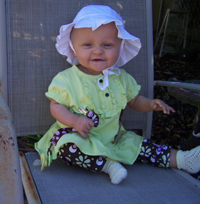Treatment for soft tissue sarcoma in children depends on the location of the tumor and therefore varies from patient to patient.
Treatment can be as simple as surgically removing the tumor using a small incision. In more serious cases, extensive surgery, aggressive chemotherapy, and radiation may be required. The course of therapy is generally determined by the tumor type or grade. Doctors use a pathological evaluation to show how fast the tumor is growing and to determine the tumor’s size and stage; in other words, they look at the tumor under a microscope to determine the extent and aggressiveness of the disease. Treatment can be somewhat less aggressive for tumors that are small, lower grade, and completely removed by surgery.
More aggressive therapy with chemotherapy and/or radiation is usually reserved for high-grade sarcomas that are larger and/or have spread to other parts of the body.
Expand all sections Close all sections
Desmoid Tumors
Desmoid tumors generally occur in the arms or legs, but can arise anywhere. Children with Gardner’s syndrome and familial polyposis coli are at higher risk of developing desmoid tumors.
Symptoms: Often present as a painless, slow growing mass.
Treatment: Surgery is the primary treatment for desmoid tumors. If the tumor cannot be completely removed or the tumor recurs, other treatment can be considered. Radiation may be used to limit local recurrence.
Outcome: The chance for recovery is excellent with the complete removal of the tumor. Factors that increase the risk of recurrence include diagnosis at a young age, aggressive features on pathology, incomplete removal of the tumor, and underlying Gardner’s syndrome or familial polyposis coli. It is recommended that children who have this type of tumor be evaluated for a specific mutation (change) in the APC gene. Some children with desmoid tumors may need to be screened for colon cancer.
Desmoplastic Small Round Cell Tumor (DSRCT)
Desmoplastic small round cell tumor (DSRCT) is a rare, highly aggressive tumor. This cancer almost always arises in the abdomen, but can develop in other parts of the body. This cancer spreads locally to the lymph nodes and the lining of the abdomen. It can also spread to the lungs, liver, and bones.
Symptoms: Symptoms depend on the primary site and extent of disease when diagnosed. Patients with abdominal tumors often present with an enlarged abdomen which is painful. Sometimes they also have nausea, vomiting and/or weight loss.
Treatment: Desmoplastic small round cell tumors are often treated with chemotherapy, radiation, and surgery. It is important to surgically remove all of the disease to eliminate the cancer. Chemotherapy is sometimes used to shrink tumors prior to surgery.
Outcome: The overall prognosis (chance of recovery) for patients with DSRCT is poor – fewer than 20% of patients are expected to live more than 5 years after diagnosis. The chance for survival is higher if doctors are able to surgically remove all tumors.
Malignant Peripheral Nerve Sheath Tumor (MPNST)
These tumors tend to arise along nerves and usually affect the extremities arms or legs. They can also arise in the abdomen, head and neck region. This cancer can be associated with a condition called neurofibromatosis. Your doctor will determine if your child has this condition.
Symptoms: Symptoms depend on the primary site of disease, but the cancer often presents as an enlarging mass with pain or changes in sensation.
Treatment: Treatment depends on the size and the grade (a pathological evaluation that shows how fast the tumor is growing). Small and low-grade (less aggressive) tumors can usually be treated with just surgery. Larger and high-grade (more aggressive) tumors may require treatment with radiation and chemotherapy in addition to surgery.
Outcome: The overall prognosis (chance of recovery) for patients with small, low-grade MPNST is excellent. The prognosis for patients with large, high-grade MPNST is still generally good, but these patients require additional therapy with radiation and/or chemotherapy.
Rhabdoid Tumors
This is a rare, but very aggressive form of cancer that tends to affect infants. The two most common primary sites are the kidney and brain. An aggressive treatment approach is often used, but most rhabdoid tumors spread to other parts of the body despite these efforts.
Synovial Sarcoma
This tumor usually develops near a joint in the leg, but can occur in other places in the body, including the lungs. Within the tumor, a specific genetic abnormality is often identified where part of one chromosome is attached to another.
Symptoms: Symptoms often are an enlarging, painless mass, usually near the knee.
Treatment: Most synovial sarcomas are treated with a combination of surgery, chemotherapy and radiation. It is important to try to completely remove the tumor. The addition of radiation and chemotherapy to treatment protocols has improved survival in patients with synovial sarcoma.
Outcome: With a combination of surgery, chemotherapy and radiation, more than 70% of patients are expected to be long-term survivors.

